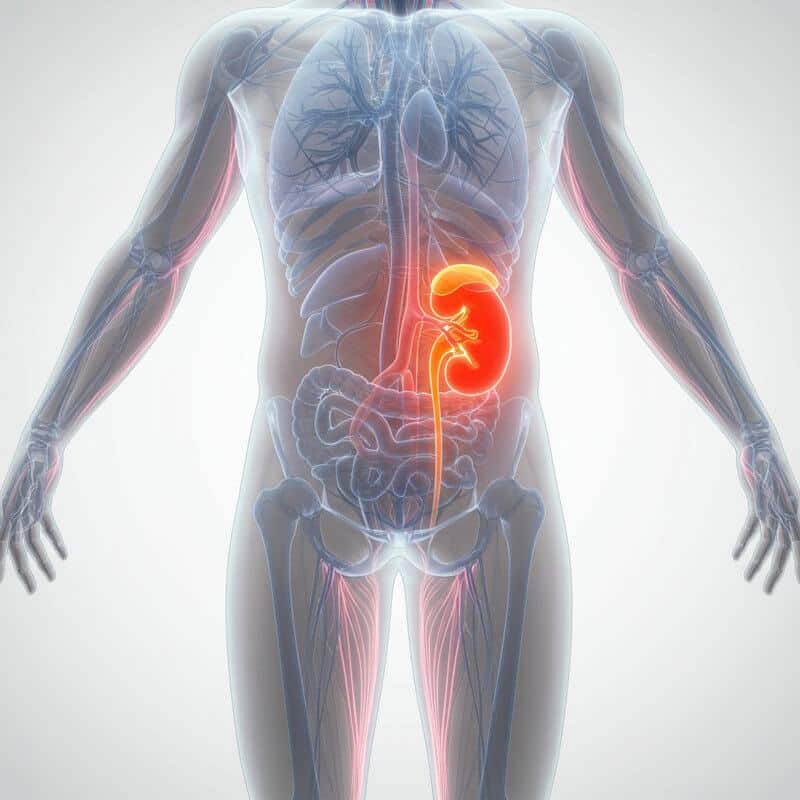Early Signs of Autism Parents Often Dismiss as: Just a Phase
Autism spectrum disorder (ASD) is a complex neurodevelopmental condition that affects approximately 1 in 36 children in the United States, according to the Centers for Disease Control and Prevention. In the UK, similar trends are seen, with over 1% of the population on the spectrum, as noted by the National Autistic Society. ASD impacts how the brain processes information, influencing communication, social interaction, and behavior. Yet, early signs often remain undetected, as parents may misinterpret these subtle cues as typical quirks or fleeting phases of childhood development. Recognizing these signs early can be crucial for timely intervention and support.
1. Limited Eye Contact

One of the earliest and most telling signs of autism in infants is limited or absent eye contact. In typical development, babies begin to make eye contact within the first few weeks of life and use this social cue to bond with caregivers, express needs, and learn about their environment. The absence of sustained eye contact may signal atypical development in the brain’s social processing centers, a hallmark often associated with ASD.
While brief lapses in eye contact can be normal, persistent avoidance by the age of 6 months is a potential red flag. Neurotypical babies will often gaze into a parent’s eyes, smile in response, or seek visual reassurance during interactions. In contrast, children on the autism spectrum may seem uninterested in faces or fail to follow a parent’s gaze. This subtle difference is frequently dismissed as shyness, temperament, or mere distraction, causing parents to overlook a critical early marker.
For more information, visit the Eunice Kennedy Shriver National Institute of Child Health and Human Development.
2. Not Responding to Name

By around 6 to 12 months, most infants begin to respond consistently when their name is called. This response reflects developing auditory processing and attention systems, as well as early social awareness. When a child does not react to their name—especially if they respond to other sounds or voices—it may indicate differences in how their brain processes social cues.
Many parents may initially assume a lack of response is due to distraction or that their child is simply “in their own world.” However, if this pattern persists beyond 12 months, it could be a sign of autism spectrum disorder. It is important to distinguish between hearing issues and social communication differences; children with ASD can often hear perfectly well but may not connect the sound of their name to social engagement.
For further details, the CDC’s Signs and Symptoms of Autism Spectrum Disorder page provides valuable insights for parents and caregivers.
3. Lack of Social Smiling

A baby’s first smile is more than a heartwarming milestone—it signals healthy social-emotional development and the early function of “mirror neurons,” which help children recognize and imitate others’ emotions. By two months, neurotypical infants often respond to a parent’s smile or playful expression with a smile of their own. This “social smiling” is a key indicator that a child is engaging with and learning from their environment.
When a baby does not smile back or rarely smiles at others by 3 to 4 months, it may suggest atypical development in social brain pathways. Parents sometimes chalk up a serious or unsmiling baby to personality, but consistent absence of reciprocal smiling can signal something more. Missed milestones, such as failing to smile in response to familiar faces or not lighting up during play, should not be overlooked.
The American Academy of Pediatrics outlines typical social development milestones that parents can use as a helpful reference.
4. Delayed Babbling

Babbling is an important stepping stone in the development of language centers in the brain. Typically, infants begin to produce repetitive sounds like “ba-ba” or “da-da” by 4 to 6 months, experimenting with tone and rhythm as they prepare for actual speech. This early vocal play is a sign that the auditory and speech-processing regions are developing as expected.
A noticeable delay or absence of babbling by 9 months may suggest atypical development, which is often seen in children with autism spectrum disorder. Some parents may dismiss a quiet baby as simply “easygoing” or “late talkers,” but a lack of babbling is a key marker that should prompt further observation. Delayed babbling is not just about words—it’s about the natural urge to communicate and interact.
For more guidance, the American Speech-Language-Hearing Association provides resources on speech and language milestones to help parents track their child’s progress.
5. Repetitive Movements (Hand Flapping)

Repetitive movements such as hand flapping, rocking, or spinning are forms of sensory-motor self-stimulation, often referred to as “stimming.” While all children engage in some self-soothing actions, persistent and intense repetitive movements can be a sign of autism spectrum disorder. For instance, a child might flap their hands rapidly when excited, spin in circles, or repetitively line up toys in a precise order.
These behaviors serve to regulate sensory input or express excitement, anxiety, or frustration. In neurotypical development, occasional repetitive actions are common—especially during moments of excitement or fatigue. However, if these movements are frequent, intense, or interfere with everyday activities, they may indicate underlying differences in sensory processing.
Parents can learn more about the differences between typical and concerning repetitive behaviors by visiting the Autism Speaks: Learn the Signs of Autism page, which offers practical examples and expert guidance.
6. Limited Gestures (Pointing/Waving)

Nonverbal communication is a crucial part of early childhood development. Babies naturally use gestures—such as pointing, waving, or reaching—to communicate needs, share experiences, and connect with others long before they can speak. By around 9 to 12 months, most children will point to show interest, wave “hello” or “goodbye,” and use open hands to indicate wanting to be picked up. These gestural milestones are foundational for social interaction and language acquisition.
A lack of gestures or limited use of nonverbal communication may be an early sign of autism. When a child does not point to objects of interest, fails to wave, or seldom uses gestures to direct attention, parents might assume their child is simply taking longer to develop these skills. However, persistent absence of gestures—especially by 12 months—should not be overlooked.
The CDC’s Milestone Checklist for 1-Year-Olds outlines expected nonverbal communication behaviors and provides tools for early detection.
7. Lack of Imitation

Imitation is a critical aspect of early childhood learning. Through imitation learning, neurotypical children begin to mimic the actions, sounds, and expressions of adults and peers from as early as a few months old. This process helps children acquire language, social skills, and a sense of connection with those around them. For example, babies might clap when a parent claps, copy funny faces, or repeat simple sounds and gestures during play.
A persistent lack of imitation, however, can be an early sign of autism. Children with ASD may not mirror behaviors, even when prompted or encouraged. This absence can show up in everyday routines, such as not copying waving, clapping, or pretending during play. Parents may attribute this to personality or independence, but consistent lack of imitation should prompt further observation.
For more information, the National Autistic Society provides detailed insights into signs of autism, including imitation difficulties.
8. Absence of Joint Attention

Joint attention is the shared focus between a child and another person on an object, event, or activity. This skill involves looking where someone else is pointing, following another’s gaze, or using gestures to draw attention to something interesting. For example, when a parent points to an airplane in the sky and a baby looks up to follow, they are engaging in joint attention. This process is vital for social learning, language development, and building relationships.
Children on the autism spectrum often lack or have difficulty with joint attention. They may not look at objects that others point to, fail to follow someone’s gaze, or rarely try to share discoveries with adults. Parents might miss these signs, attributing them to distractibility or personality. However, if joint attention skills are not developing by 12 to 18 months, it is important to seek further assessment.
The NICHD’s Signs and Symptoms of Autism page provides further information on joint attention and related social skills.
9. Unusual Attachment to Objects

It’s natural for young children to develop favorite toys or comfort objects, such as a beloved stuffed animal or blanket. However, children with autism spectrum disorder may display intense fixation on specific objects or unusual items—sometimes focusing on things like a particular spoon, a piece of string, or the wheels of a toy car rather than the whole toy. These attachments can go beyond typical preferences, with the child insisting on carrying the object everywhere or becoming extremely distressed if it’s unavailable.
While neurotypical children often cycle through interests, those on the autism spectrum may display a repetitive, almost ritualistic focus on their chosen object. This behavior might include lining up or sorting items in a precise way or becoming absorbed in the object’s sensory qualities, such as spinning or watching it closely for extended periods. Parents might dismiss this as a harmless quirk, but when the attachment is unusually strong or interferes with play, social interactions, or daily routines, it could be a sign of ASD.
Find more about this behavior at the Autism Speaks: Signs of Autism resource.
10. Insistence on Sameness
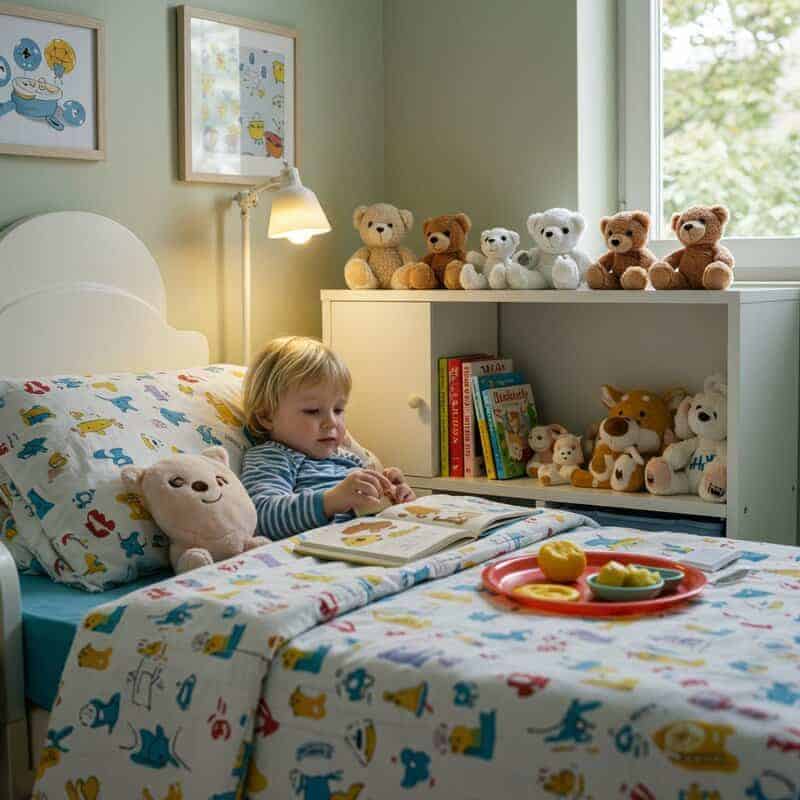
Many children enjoy routines and familiar patterns, but those with autism spectrum disorder may exhibit an intense need for sameness and become distressed by even minor changes. This rigidity can manifest in various ways, such as insisting on eating the same foods every day, following identical routes to school, or requiring a specific sequence during bedtime routines. The comfort derived from predictability goes beyond typical preferences—it becomes a necessity for the child’s sense of security.
Neurotypical children may occasionally protest changes, yet adapt with reassurance and time. In contrast, children with ASD might experience significant anxiety, meltdowns, or withdrawal when routines are disrupted. For example, a child could react strongly if someone moves their toys or if an unexpected visitor arrives. While occasional inflexibility is normal, persistent and extreme insistence on sameness—especially if it interferes with daily life—warrants a closer look.
For more on this topic, the CDC’s Signs of Autism Spectrum Disorder page outlines the importance of flexibility in child development.
11. Hyper- or Hypo-Sensitivity to Sensory Input

Children with autism often display abnormal sensory processing, which means they may be unusually sensitive (hyper-sensitive) or under-responsive (hypo-sensitive) to sights, sounds, textures, tastes, or smells. For some, everyday noises—like a vacuum cleaner or a busy supermarket—can be overwhelming, leading to covering ears or meltdowns. Others may barely react to loud sounds or seem indifferent to pain or temperature extremes.
While all children have sensory preferences, those with autism experience reactions that are notably more intense or absent compared to their peers. For example, a child might gag at the texture of certain foods, recoil from bright lights, or insist on wearing only specific fabrics. Conversely, some children may seek out intense sensory experiences, like spinning, crashing into objects, or watching spinning fans for long periods.
Learn more about sensory processing and autism at the Autism Speaks: Sensory Issues resource page.
12. Unusual Reaction to Sounds
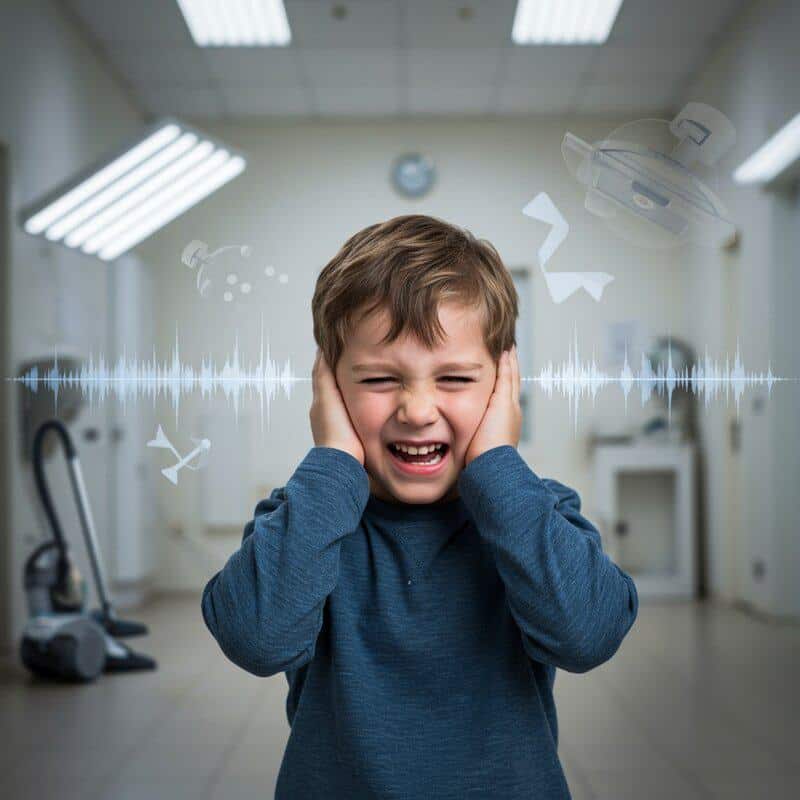
Auditory processing differences are common in children with autism spectrum disorder, often resulting in either extreme sensitivity or indifference to sounds. Some children may cover their ears or become highly distressed by everyday noises like the vacuum cleaner, hand dryers, or even the hum of fluorescent lights. Others may appear to ignore loud noises altogether, not reacting to their own name being called or to sudden, startling sounds.
These unusual reactions go beyond typical startle responses or fleeting fears. For example, a child might become anxious at the sound of a dog barking or insist on turning off music or appliances that others barely notice. Alternatively, an indifference to sounds—such as not responding to sirens or alarms—may be mistaken for hearing loss. However, hearing tests often come back normal, indicating that the issue lies in how the brain processes auditory stimuli.
The National Autistic Society: Sensory Differences page provides more information and practical advice for families.
13. Delayed Speech or No Single Words by 16 Months

By 12 to 16 months, most children begin to say their first meaningful words, such as “mama,” “dada,” or the names of familiar objects. These early speech milestones mark crucial progress in language development and communication skills. When a child is not using any single words by 16 months, or only uses a very limited vocabulary, it may indicate a developmental delay that warrants attention.
While some children may simply be “late talkers,” persistent delays—especially when combined with other social or communication challenges—can be an early sign of autism spectrum disorder. It’s important for parents to monitor not only the number of words but also how the child uses speech to interact with others. A lack of attempts to communicate, even with gestures or sounds, is more concerning than quietness alone.
For more information on typical speech milestones and when to seek help, visit the American Speech-Language-Hearing Association’s Speech and Language Development resource.
14. Regression in Skills

One of the more alarming early signs of autism is regression—the loss of previously acquired skills. This can include losing words a child once used, ceasing to make eye contact, or no longer engaging in social games they had previously enjoyed. For example, a toddler who once said “bye-bye” and waved may suddenly stop doing both, or a child who used to babble and imitate sounds might become noticeably quieter over several weeks.
Regression often occurs between 15 and 24 months but can happen at any age. Parents sometimes attribute this to stress, illness, or changes in environment, but true regression—especially in communication or social engagement—should never be ignored. This sudden loss is a significant red flag for autism spectrum disorder and other neurodevelopmental conditions.
For more on the importance of early action in cases of skill regression, see the CDC: Signs and Symptoms of Autism Spectrum Disorder page.
15. Lack of Interest in Peers

A key aspect of early childhood is social motivation—the natural drive to interact with and learn from other children. Most toddlers show curiosity about peers, making efforts to watch, approach, or play alongside them, even before they can fully participate in group games. This early engagement is crucial for developing communication, empathy, and social skills.
Children with autism spectrum disorder may show little to no interest in other children, preferring solitary play or focusing on objects instead of people. This disinterest is more than mere shyness or a phase of independence; it’s a consistent pattern where the child does not attempt to join, imitate, or observe peers during playtime. Parents may notice their child is content to play alone, rarely seeks out other children, or ignores invitations to interact.
The NHS: Signs of Autism in Children page details the differences between typical social development and signs that may warrant professional evaluation.
16. Unusual Play Patterns
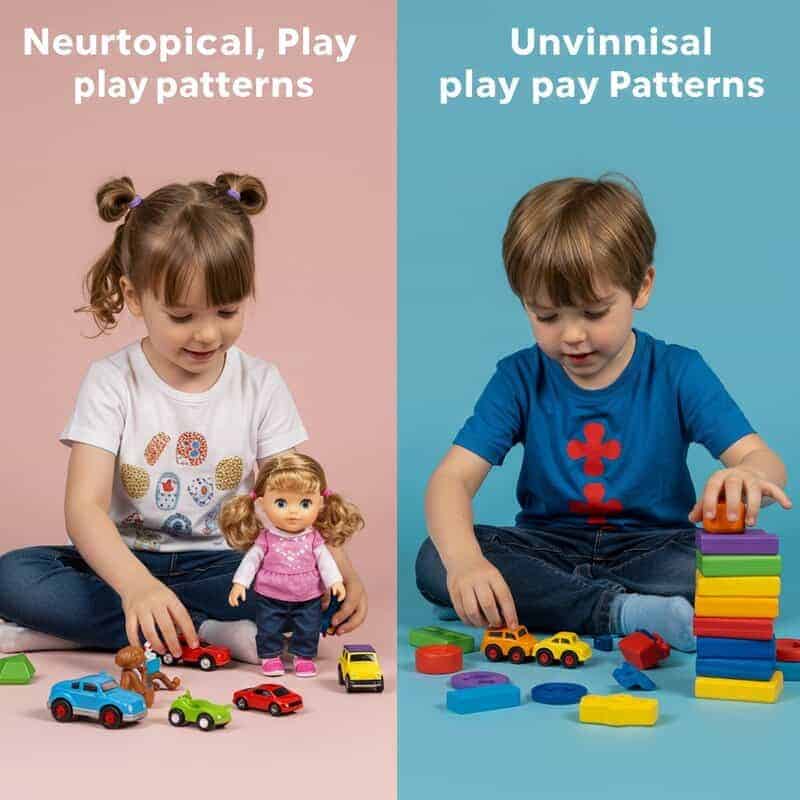
Play is a window into a child’s developing mind. Neurotypical children often engage in imaginative play, such as pretending to feed a doll, driving toy cars around, or creating stories with action figures. These activities foster creativity, problem-solving, and social understanding. In contrast, children with autism spectrum disorder may display repetitive or nonfunctional play patterns. Instead of using toys as intended, they might line up cars, spin wheels, or stack blocks in the exact same way every time.
Unusual play can also involve focusing on only one aspect of a toy—such as opening and closing a door repeatedly—or becoming absorbed in visual or sensory elements, like watching light reflections. While some repetition is normal, especially in the early years, a strong preference for repetitive play without transitioning to pretend play by age two may signal a concern.
For more on typical and atypical play milestones, see the Zero to Three: Early Signs of Autism resource for parents and caregivers.
17. Difficulty with Transitions

Adaptability is a key part of healthy development, helping children manage everyday changes and new experiences. While most young children may grumble about leaving the playground or stopping a favorite activity, they usually adjust after a brief protest. Children with autism spectrum disorder, however, often struggle significantly with transitions—shifting from one activity, environment, or routine to another.
Examples of challenging transitions include moving from playtime to mealtime, switching classrooms, or even shifting attention from one toy to another. These changes can trigger extreme distress, tantrums, or a complete shutdown. The reaction may seem out of proportion to the situation and persist despite repeated exposure or reassurance. Parents might initially interpret this as stubbornness or a strong-willed personality, but consistent, severe resistance to transitions is a notable sign.
For further reading on transition difficulties and autism, the Autism Speaks Transition Tool Kit offers practical guidance and support for families.
18. Absence of Pretend Play
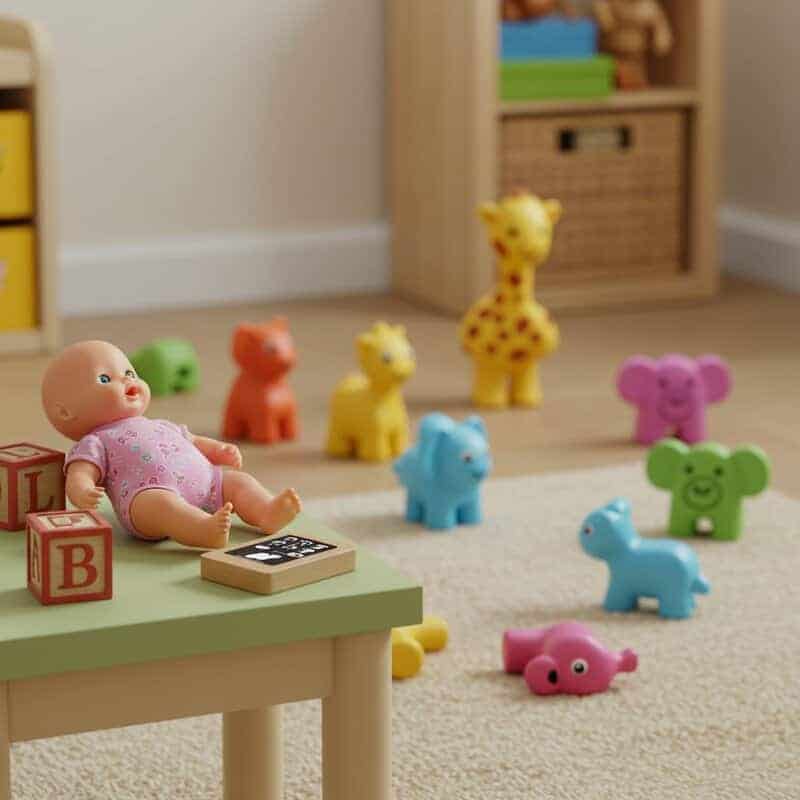
Pretend play, or symbolic play, typically emerges between 18 and 24 months as children begin to use objects and actions to represent real-world scenarios. This might look like feeding a baby doll, pretending a block is a phone, or making animal figures “talk” to each other. Such creativity is not only entertaining but also essential for the development of social, cognitive, and language skills.
Children with autism spectrum disorder often show an absence of pretend play, preferring repetitive or functional use of toys instead. Instead of making a toy car “zoom,” they may only spin its wheels, or they might stack blocks rather than build imaginative structures. Parents sometimes overlook this gap, assuming their child will develop pretend play later, but missing this milestone by age two is cause for concern.
For more on the importance of pretend play and how its absence may signal developmental differences, see the CDC Milestones: 2 Years page.
19. Poor Motor Coordination

Motor skill development is a key part of early childhood, encompassing both fine motor skills (like grasping small objects or using a spoon) and gross motor skills (such as crawling, walking, or jumping). While all children develop at their own pace, children with autism spectrum disorder may exhibit poor motor coordination that goes beyond occasional clumsiness. These challenges can affect everyday activities, making it harder for them to navigate their environment or participate in play.
Parents might notice that their child struggles to catch a ball, climb stairs, or use utensils effectively, often lagging behind peers in mastering physical milestones. They may appear unusually uncoordinated, bump into things, or have trouble with tasks like stacking blocks or drawing simple shapes. While some clumsiness is typical, persistent delays or awkwardness—especially when coupled with other early warning signs—should prompt further evaluation.
For more on developmental motor milestones, visit the CDC’s Developmental Milestones overview, which offers checklists for parents to track their child’s progress.
20. Difficulty Understanding Emotions

Children typically begin to develop emotional recognition skills early in life, learning to read facial expressions, voice tones, and body language. By age two, many children can identify when someone is sad, happy, or angry and may offer comfort or react appropriately. In contrast, children with autism spectrum disorder often struggle to interpret or respond to the emotions of others, sometimes appearing indifferent or confused during emotionally charged situations.
Parents may observe that their child does not seem to notice when a peer is upset, fails to respond to comforting or scolding, or misses obvious social cues like a parent’s smile or frown. Rather than joining in laughter or seeking comfort, the child may remain detached or become overwhelmed by emotional displays. These difficulties can impact relationships and social development, often going unnoticed in early years as “aloofness” or shyness.
For guidance on emotional and social development, the Raising Children Network: Emotional Development and ASD offers helpful resources for parents and caregivers.
21. Does Not Share Interests

Sharing interests is a core aspect of social reciprocity—the natural give-and-take that forms the basis of early relationships. Most young children love to show parents and caregivers their favorite toys, drawings, or discoveries, eagerly seeking acknowledgment or praise. This behavior, such as holding up a toy or pointing out something exciting, signals a child’s awareness of others’ attention and a desire to connect.
Children with autism spectrum disorder, however, may not spontaneously share their interests. Rather than bringing a toy to show a parent or pointing to something they find fascinating, they may keep to themselves or fail to seek others’ reactions. Parents might notice their child playing alone with a favorite object but not attempting to involve anyone else. This lack of sharing can sometimes be mistaken for independence, but it is actually a significant difference in how a child relates to the world.
The CDC: 2-Year Milestones page offers more insight on what to expect regarding sharing and social engagement.
22. Unusual Vocalizations

Atypical sounds and speech patterns are common in children with autism spectrum disorder. These unusual vocalizations can include repetitive noises, high-pitched squeals, humming, or the use of odd rhythms and tones. Echolalia—repeating words, phrases, or even entire dialogues heard from others or media—is also frequently observed. While echoing speech can be part of typical language development, persistent or excessive echolalia may signal a deeper issue.
Parents might notice their child repeating the same word or phrase over and over, mimicking commercials, or using a sing-song or robotic tone when speaking. Some children may produce animal sounds, click their tongue, or make non-speech noises at inappropriate times. These vocal quirks are often dismissed as playful experimentation, but if they persist or dominate a child’s communication style, they warrant closer observation.
The American Speech-Language-Hearing Association: Autism Spectrum Disorder page provides valuable information about communication differences and what to watch for in early development.
23. Overly Focused on Parts of Objects

A notable early sign of autism spectrum disorder is a strong, persistent interest in specific parts of objects rather than the object as a whole. This detail-focused perception means that, for example, a child might become fascinated by the spinning wheels on a toy car, the texture of a button, or the way light reflects off a shiny surface. Rather than pushing the car across the floor or engaging in pretend play, the child may spend long periods staring at, spinning, or touching just one feature.
While it’s normal for all children to explore toys in different ways, most will eventually move on to broader, more imaginative play. When a child remains preoccupied with a single aspect—such as flipping pages of a book without looking at the pictures or repeatedly flicking a doll’s hair—this can limit learning and social interaction. Parents may see this as a quirky habit, but ongoing, intense fixation on parts of objects rather than using them in typical ways should not be ignored.
More information can be found at the CDC’s Signs of Autism Spectrum Disorder resource page.
24. Unusual Gaze Patterns

Children with autism spectrum disorder often display unusual gaze patterns that set them apart from their neurotypical peers. While most children naturally engage in “gaze following”—where they look at what another person is focusing on—children with ASD may avoid eye contact, look through or past people, or fixate on objects in a way that seems disconnected from social interaction. These differences can make it challenging for them to pick up on subtle cues and share experiences with those around them.
Neurotypical children frequently shift their gaze between objects and caregivers, using looks to communicate interest or seek approval. In contrast, children with autism might stare at lights, look out of the corners of their eyes, or avoid direct eye contact altogether. Consistently atypical gaze patterns—such as failing to meet someone’s eyes when called or not following a parent’s pointing finger—are signs worth noting.
For more on gaze and early indicators of autism, see the NICHD: Signs and Symptoms of Autism Spectrum Disorder page.
25. Inappropriate Laughing or Giggling

Emotional regulation is a key developmental skill, helping children respond to emotions and situations in ways that are socially appropriate. For children with autism spectrum disorder, incongruent laughter—laughing or giggling at times that don’t match the social context—is a common but often overlooked sign. Instead of laughing at a joke or during play, a child might burst into giggles when others are sad, angry, or when nothing outwardly funny is happening.
Examples include laughing during quiet or serious moments, giggling when someone is hurt or upset, or breaking into laughter while alone with no apparent trigger. While all children sometimes laugh at odd times, frequent and persistent inappropriate laughter may indicate difficulties in processing social cues or regulating emotional responses. Parents may initially shrug off this behavior as harmless or quirky, but monitoring how often and in what situations it occurs can provide valuable information for professionals.
For guidance on emotional regulation and autism, visit the Autism Speaks: Sensory Issues page, which explains how emotional responses can differ in children with ASD.
26. Apparent Insensitivity to Pain
Altered pain perception is a striking feature sometimes observed in children with autism spectrum disorder. Unlike neurotypical children, who generally cry, seek comfort, or draw attention to minor scrapes or bumps, a child with ASD may show apparent insensitivity to pain. Parents might notice that their child does not react to injuries, such as falls, bruises, or even more significant accidents, in ways expected for their age.
For example, a child might not flinch, cry, or ask for help after a hard knock, or may continue playing despite sustaining a cut or bump. This lack of reaction can be confusing or concerning for caregivers, who may mistakenly believe their child has an unusually high pain tolerance or simply “doesn’t notice.” In truth, differences in sensory processing can cause children with autism to experience, interpret, or communicate pain differently.
The National Autistic Society: Sensory Differences page offers insight into sensory processing and pain perception in autism.
27. Avoidance of Physical Touch

Tactile sensitivity is a common trait among children with autism spectrum disorder and can significantly influence how they experience physical affection. Unlike most children, who typically enjoy hugs, cuddling, or playful pats, those with ASD may exhibit a strong avoidance of physical touch. Parents may notice their child pulling away from embraces, stiffening when held, or refusing to hold hands even with trusted caregivers.
Real-life examples include a child shrinking away from a gentle touch on the arm, becoming upset during routine activities like hair brushing or nail trimming, or avoiding close physical contact with peers during play. While all children can have moments of wanting personal space, consistent and extreme avoidance of touch—especially when it leads to distress or interferes with daily routines—is a sign that should not be dismissed as a passing phase.
For more on tactile sensitivity and autism, the Autism Speaks: Sensory Issues page provides helpful information for families and caregivers.
28. Difficulty Adjusting to Loud Environments
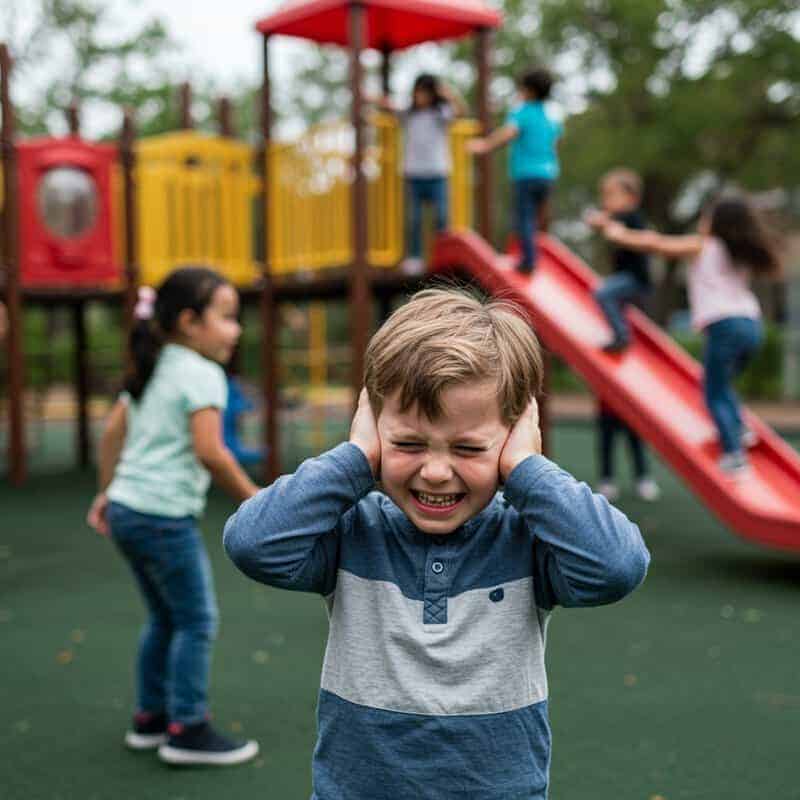
Many children are startled by sudden loud noises, but most quickly adapt to bustling, noisy places like playgrounds, parties, or shopping malls. Children with autism spectrum disorder, however, may experience sensory sound overload that makes it extremely difficult for them to adjust to loud environments. The result can be overwhelming distress, covering ears, crying, or even fleeing from the source of noise.
Parents may notice their child reacting strongly to everyday situations: becoming anxious in crowded stores, refusing to enter birthday parties, or melting down at the sound of clapping or music. While occasional discomfort with noise is normal, ongoing, intense reactions that impair participation in family or social activities should not be overlooked. These behaviors may be a sign of sensory processing differences commonly associated with autism.
For more on sensory sound issues and autism, visit the National Autistic Society: Sensory Differences page, which offers practical advice for families.
29. Strong Reactions to Smells or Tastes

The senses of taste (gustatory) and smell (olfactory) play an important role in how children experience the world. For many children with autism spectrum disorder, gustatory and olfactory processing can be unusually heightened or diminished, leading to strong reactions to specific flavors or odors. This might result in extreme aversions to certain foods, gagging at mild smells, or even seeking out strong tastes and scents that others find unpleasant.
Practical examples include a child who refuses to eat foods with particular textures or flavors, becomes distressed by the smell of cleaning products or perfumes, or shows an obsessive interest in sniffing objects or people. While picky eating is common in young children, persistent, intense reactions that disrupt meals or daily routines are not typical and may reflect sensory processing differences.
For more information on sensory sensitivities related to taste and smell, see the Autism Speaks: Sensory Issues page, which offers guidance on managing these challenges.
30. Limited Use of Facial Expressions

Facial expressivity is a vital component of nonverbal communication and social connection in early childhood. Most neurotypical children naturally use a wide range of facial expressions—from smiles and frowns to surprise and excitement—to convey their feelings and respond to others. These reactions are often spontaneous and reflect a child’s engagement with their surroundings.
Children with autism spectrum disorder may demonstrate limited use of facial expressions, appearing unusually neutral or “flat” in their affect. Parents might notice that their child rarely smiles back, shows little visible enjoyment during play, or doesn’t mimic others’ emotional responses. Even in exciting or upsetting situations, the child’s face may remain unchanged, making it harder for others to read their emotions or intentions.
For more about facial expressivity and autism, visit the CDC: Signs and Symptoms of Autism Spectrum Disorder resource for detailed developmental guidance.
31. Difficulty Following Simple Instructions

Receptive language processing—the ability to understand and act on spoken directions—is a crucial developmental milestone in early childhood. Most neurotypical children begin to follow simple instructions like “come here,” “give me the ball,” or “sit down” by their first birthday. This ability reflects not only language comprehension but also attention and engagement with the speaker.
Children with autism spectrum disorder may consistently struggle to follow even basic commands. Parents might observe their child ignoring requests, responding with unrelated actions, or seeming confused by instructions that other children their age grasp easily. For example, a child may not hand over a toy when asked, fail to look at a parent when called, or not stop when told “no.” These challenges can extend beyond language and may indicate broader communication or processing differences.
For more information on receptive language milestones, visit the American Speech-Language-Hearing Association: Speech and Language Development resource.
32. Absence of Back-and-Forth Conversation

Conversational reciprocity—the ability to engage in a two-way exchange of ideas, questions, and responses—is a key social and communication skill. By age two, most children begin to participate in simple back-and-forth conversations, responding to questions, asking their own, or sharing reactions in turn. This early turn-taking is foundational for building relationships and developing more complex language skills.
Children with autism spectrum disorder often struggle with this kind of exchange. Instead of responding to questions, they may give unrelated answers, repeat phrases, or dominate conversations without waiting for a reply. Some may barely initiate conversation at all, while others may talk at length about a favorite topic but not pause for another person’s input. Parents may notice that conversations feel one-sided or that the child doesn’t appear interested in sharing or listening.
For more on early conversational skills and autism, visit the CDC: Milestones for 2-Year-Olds resource for guidance and checklists.
33. Monotonous or Sing-Song Speech
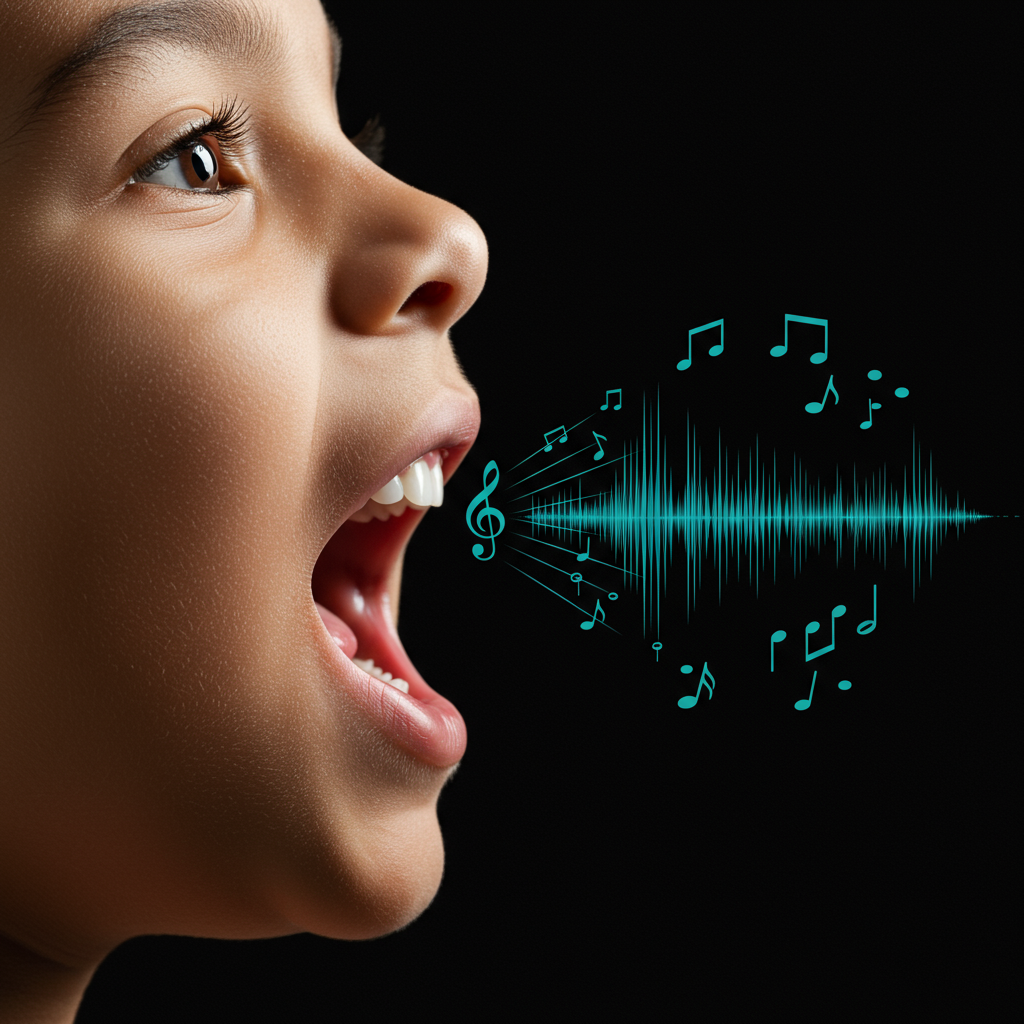
Prosody refers to the rhythm, pitch, and intonation of spoken language—the musical qualities that make speech expressive and engaging. Most children naturally develop a range of prosody, using rising and falling tones to express excitement, ask questions, or convey emotion. In contrast, children with autism spectrum disorder may speak in a monotonous or sing-song voice that stands out from their peers.
For example, a child might speak in a flat, unvarying tone regardless of the situation, making it difficult to tell when they are happy, upset, or asking a question. Others may use exaggerated, melodic speech or repeat the same musical intonation in all conversations. These differences can affect how others perceive and understand the child’s emotions and intentions, sometimes leading to misunderstandings or social challenges.
For more on prosody and speech patterns in autism, visit the American Speech-Language-Hearing Association: Autism Spectrum Disorder resource, which provides guidance for parents and caregivers.
34. Excessive Lining Up of Objects

One distinctive repetitive behavior often observed in children with autism spectrum disorder is the excessive lining up of objects. While many young children occasionally arrange toys in a row during play, this activity is typically brief and flexible. In contrast, children with autism may spend extended periods meticulously lining up cars, blocks, or household items, becoming distressed if the sequence is disrupted or altered.
This behavior differs from imaginative or constructive play, as the focus is on the order and precision of the arrangement rather than the function or story behind the objects. Parents might notice their child repeatedly returning to this activity, even when encouraged to try other forms of play. The pattern may extend to arranging shoes, utensils, or anything that can be sorted or lined up in a specific way.
For more insight on repetitive play and autism, visit the CDC: Signs and Symptoms of Autism Spectrum Disorder resource.
35. Difficulty Expressing Needs

Children with autism spectrum disorder often experience communication challenges that make it hard for them to express their needs, wants, or feelings. While all young children may struggle to communicate at times, those with ASD might have persistent trouble using words, gestures, or even crying to indicate when they are hungry, thirsty, tired, or uncomfortable. Instead, their frustration may manifest as tantrums, withdrawal, or self-soothing behaviors such as rocking or hand-flapping.
Parents may notice their child standing silently by the refrigerator instead of asking for a snack, or becoming upset when a favorite toy is out of reach without pointing or requesting help. Over time, these communication barriers can lead to increased feelings of frustration for both the child and their caregivers. Persistent difficulty in expressing basic needs—especially beyond the toddler years—should not be dismissed as shyness or stubbornness.
The American Speech-Language-Hearing Association: Autism Spectrum Disorder page offers more information and support regarding communication difficulties in autism.
36. Unusual Postures

Some children with autism spectrum disorder display atypical body movements or postures that set them apart from their peers. While all children may occasionally sit, stand, or move in quirky ways, persistent and unusual postures can be a sign of underlying sensory or motor differences. These might include toe-walking, holding arms stiffly at their sides, bending their body at odd angles, or standing with their head tilted for extended periods without an obvious reason.
Other examples include sitting in a “W” shape, frequently arching the back, or adopting rigid, tense stances during play or rest. Some children may assume unusual hand or finger positions, such as fanning or splaying fingers, or holding objects in unconventional ways. While these behaviors may seem harmless or even unique, consistent patterns of unusual posture can interfere with movement, comfort, or participation in activities.
For further information on motor signs and autism, review the Autism Speaks: Learn the Signs of Autism resource.
37. Lack of Fear or Excessive Fearfulness

Atypical responses to fear are frequently seen in children with autism spectrum disorder. While most children show age-appropriate caution—such as hesitating near stairs, backing away from strangers, or showing anxiety around loud noises—children with ASD may display either a striking lack of fear or an overwhelming, excessive fearfulness. These extremes can create safety concerns or limit a child’s ability to explore and learn from new experiences.
For example, some children might engage in risky behaviors like climbing high furniture, running into the street, or approaching unfamiliar animals without hesitation. On the other hand, others may become intensely anxious in ordinary situations, such as entering a new room, seeing a common object, or hearing routine sounds. These strong reactions are often out of proportion to the situation and may not improve with reassurance or repeated exposure.
For more on fear responses and autism, visit the National Autistic Society: Fears and Phobias resource for helpful insights and tips.
38. Difficulty Sleeping

Sleep regulation is a complex process that can be especially challenging for children with autism spectrum disorder. While occasional sleep disturbances are common in early childhood, persistent difficulty sleeping—such as trouble falling asleep, frequent night wakings, or waking up extremely early—may signal a deeper issue. Children with ASD often experience differences in their circadian rhythms, sensory processing, or anxiety levels that can interfere with restful sleep.
Parents may notice their child resisting bedtime routines, taking an unusually long time to settle, or waking throughout the night and struggling to return to sleep. Some children may be highly sensitive to environmental factors like light, noise, or changes in temperature, further disrupting their sleep patterns. Over time, chronic sleep difficulties can impact mood, behavior, and overall development.
For more on sleep problems and autism, visit the Autism Speaks: Sleep and Autism page, which offers resources and strategies for improving sleep in children with ASD.
39. Persistent Tantrums Without Clear Cause

Emotional regulation is a developing skill for all young children, and tantrums are a normal part of early childhood. However, children with autism spectrum disorder often face unique challenges in managing emotions. Unlike typical tantrums, which usually have clear triggers—such as hunger, tiredness, or frustration at being denied something—tantrums associated with ASD may appear to occur “out of the blue,” with no obvious reason.
Parents might notice their child melting down in calm settings, during transitions, or in response to subtle changes that wouldn’t usually upset most children. These outbursts can be intense, frequent, and difficult to soothe, sometimes lasting longer than expected. Because the triggers aren’t always apparent, it can be challenging for families to predict or prevent these episodes.
For more on emotional regulation and tantrums in autism, visit the Autism Speaks: Behavioral Health Challenges resource.
40. Unusual Walking Patterns (Toe Walking)

Motor development in early childhood relies on sensory feedback and muscle coordination. Most children progress from crawling to walking with a flat-footed, balanced gait. However, some children with autism spectrum disorder exhibit unusual walking patterns, such as persistent toe walking—where they walk on the balls of their feet rather than with heels touching the ground. While brief periods of toe walking can be normal during toddler years, ongoing or exclusive toe walking past age two may indicate underlying sensory or neurological differences.
Parents might observe their child tiptoeing across rooms, avoiding flat-footed walking even on different surfaces, or showing a preference for running or skipping on toes. This behavior can be linked to differences in sensory processing, as some children may seek the unique sensation or pressure that toe walking provides. While occasional toe walking is common, persistent patterns—especially when accompanied by other developmental concerns—should prompt a discussion with your pediatrician.
For more about toe walking and autism, visit the Autism Speaks: Sensory Issues page for practical information and support.
41. Intense Focus on Specific Topics

Children with autism spectrum disorder often exhibit restricted interests, showing an intense and sometimes all-consuming focus on particular subjects or objects. While most children go through phases of fascination—such as dinosaurs, trains, or a favorite character—these interests typically rotate and are balanced with curiosity about other things. In contrast, children with ASD may devote most of their time and conversation to a single topic, often to the exclusion of other activities or social engagement.
Examples include memorizing detailed facts about elevators, becoming preoccupied with maps, or wanting to talk endlessly about weather patterns. This focus can be so strong that the child struggles to switch topics, join other play, or participate in group activities that don’t involve their area of interest. While deep knowledge and enthusiasm are positive traits, when a child’s interests are so narrow or intense that they interfere with learning, friendships, or family life, it may be a sign of autism.
For more on restricted interests, visit the CDC: Signs and Symptoms of Autism Spectrum Disorder resource page.
42. Difficulty Making Friends

Developing friendships is an important part of social skill development in childhood. By preschool age, most neurotypical children begin to form simple connections with peers, engaging in cooperative play, sharing, and responding to social cues. They might seek out playmates, invite others to join games, or show excitement about birthday parties and group activities. In contrast, children with autism spectrum disorder often face persistent challenges in making and maintaining friendships.
Parents may notice their child prefers solitary play, doesn’t respond to invitations from peers, or struggles to understand the give-and-take of social interactions. Attempts at friendship may be awkward, limited to shared interests, or marked by difficulty interpreting others’ feelings and intentions. While some children may desire friends but lack the skills to connect, others may seem content alone, further complicating early detection.
For more on social skill development and autism, see the CDC: Signs and Symptoms of Autism Spectrum Disorder page for additional guidance.
43. Extreme Distress Over Minor Changes

A strong need for predictability is a hallmark of autism spectrum disorder, often resulting in extreme distress when routines are disrupted or even small changes occur. While most young children may be momentarily upset by changes in plans, they usually adapt with reassurance. Children with ASD, however, may become inconsolable or experience meltdowns over seemingly minor alterations to their daily routine or environment.
Real-life examples include a child reacting with intense anxiety if a favorite cup is unavailable, if a toy is moved out of place, or if the order of activities is altered—such as taking a different route to school or changing the sequence of a bedtime routine. These overreactions are not simply stubbornness; they reflect genuine discomfort and difficulty coping with unpredictability.
For more about the need for sameness and distress over changes, visit the CDC: Signs and Symptoms of Autism Spectrum Disorder resource.
44. Unusual Use of Objects
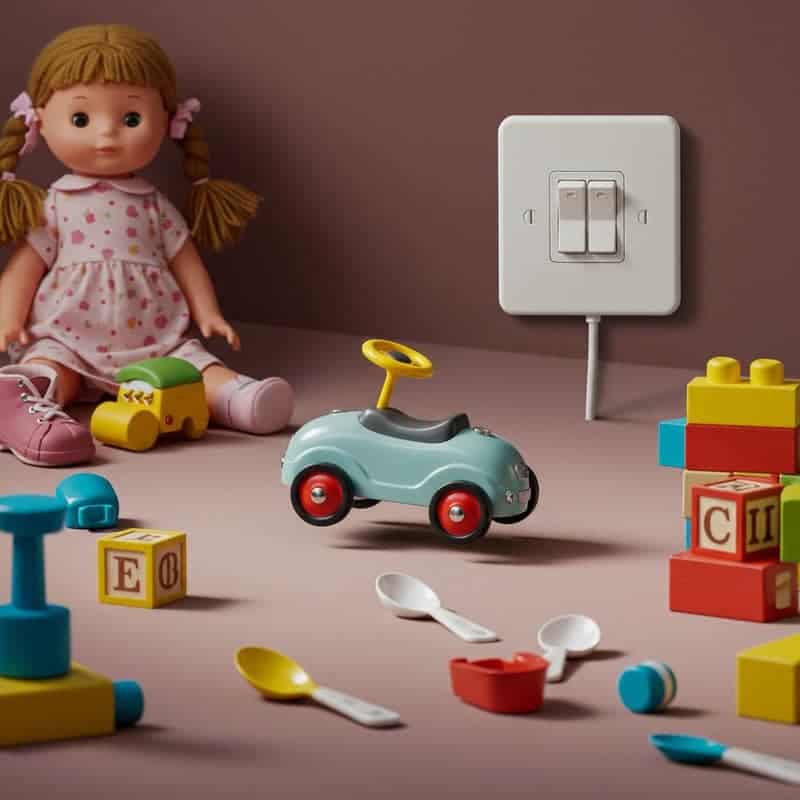
Children with autism spectrum disorder often interact with objects in nonfunctional or atypical ways that differ from neurotypical play. Instead of using toys as intended—like driving cars, feeding dolls, or building towers—they may engage in repetitive or unconventional actions. Examples include spinning the wheels of a toy car instead of rolling it, lining up household items like shoes or spoons, or flicking light switches on and off for extended periods.
Other practical examples include obsessively opening and closing doors, watching the movement of ceiling fans, or stacking objects in precise patterns. While all children may experiment with objects in creative ways as part of normal exploration, persistent and exclusive use of items in unusual ways—especially when it interferes with social or imaginative play—can be a sign of autism.
For more guidance, visit the CDC: Signs and Symptoms of Autism Spectrum Disorder page for descriptions of typical and atypical object use.
45. Lack of Interest in Stories or Songs

Narrative and shared attention are foundational skills in early childhood, helping children connect with others through books, songs, and storytelling. Most young children eagerly participate in reading sessions, enjoy being sung to, and actively respond to the rhythms, melodies, and repetitive phrases found in favorite stories or nursery rhymes. These activities foster language development, imagination, and social bonding.
Children with autism spectrum disorder, however, may show little or no interest in stories or songs. They might wander away during story time, fail to respond to familiar tunes, or seem disengaged even when invited to join in. This persistent disinterest can make it difficult for parents and caregivers to share joyful, interactive moments that are typically part of early learning. While occasional distraction is normal, ongoing lack of engagement in shared narrative or musical activities can be a sign to monitor.
For more on narrative engagement and early signs of autism, see the CDC: Signs and Symptoms of Autism Spectrum Disorder resource.
46. Unusual Eating Habits

Children with autism spectrum disorder frequently exhibit unusual eating habits due to heightened sensory sensitivities. These may include strong aversions to certain textures, colors, temperatures, or smells of foods. For example, a child might refuse to eat anything except crunchy snacks, avoid foods that are mixed together, or insist on eating only white or beige items. Some children will even gag or become distressed if presented with new or disliked foods.
Restricted diets are also common, with some children consuming only a handful of preferred foods for weeks or months on end. This can lead to nutritional imbalances, feeding difficulties, and increased stress for families at mealtimes. While picky eating is normal to some extent in early childhood, persistent and severe eating restrictions—especially when paired with strong sensory aversions—may indicate an underlying sensory processing issue linked to autism.
For more information on feeding challenges and autism, visit the Autism Speaks: Feeding Behavior resource, which offers practical strategies for parents and caregivers.
47. Absence of Social Referencing
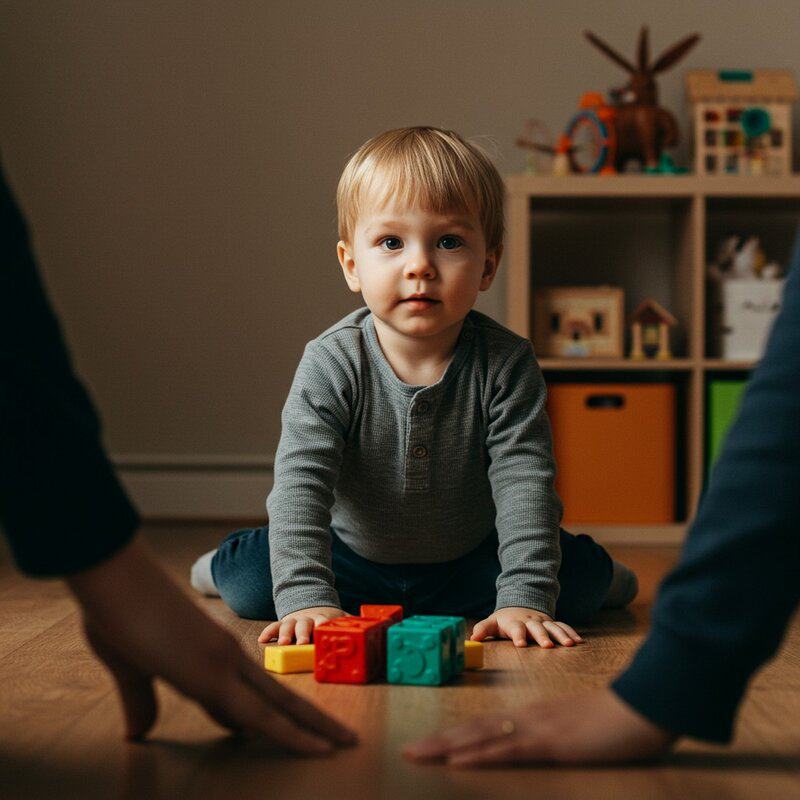
Social referencing is the process by which young children look to trusted adults or caregivers for cues about how to react in unfamiliar situations. In typical development, a child may glance at a parent’s face to gauge whether a new toy is safe, to see if a stranger is friendly, or to determine how to respond to an unexpected sound. This back-and-forth exchange helps children learn appropriate emotional and social responses.
Children with autism spectrum disorder may show an absence of social referencing. Instead of seeking reassurance or guidance from parents, they might ignore adults in new environments, react independently to novel events, or fail to notice when caregivers display concern, excitement, or encouragement. This lack of checking in can make it harder for them to learn social norms and may indicate broader challenges with social communication.
For more information on social referencing and related early social skills, visit the CDC: Signs and Symptoms of Autism Spectrum Disorder page.
48. Unusual Sensitivity to Clothing or Textures

Many children with autism spectrum disorder experience tactile defensiveness, a heightened sensitivity to touch that can make certain fabrics, tags, or seams feel unbearable against their skin. This unusual sensitivity often leads to strong aversions to specific types of clothing, such as socks with seams, wool sweaters, or shirts with tags. Some children may refuse to wear new clothes, strip off layers, or become distressed when dressed in anything outside their preferred textures.
Examples include a child insisting on wearing the same soft shirt every day, avoiding shoes altogether, or melting down when required to put on a costume or jacket. While all children have clothing preferences, persistent and extreme reactions to common fabrics or textures—especially when it disrupts daily routines—may indicate sensory processing challenges.
For more about tactile sensitivities and sensory processing in autism, visit the Autism Speaks: Sensory Issues resource.
49. Delayed Toilet Training

Toilet training requires a child to coordinate physical sensations, body movements, and communication cues. Most neurotypical children begin to show readiness for potty training between ages two and three, learning to recognize when they need to use the bathroom and communicating that need to caregivers. For children with autism spectrum disorder, delayed toilet training is common due to challenges in sensory awareness, communication, and adapting to new routines.
Parents may notice their child has difficulty recognizing when they need to go, struggles to communicate bathroom needs, or resists changes in toileting routines. Some children may remain in diapers or have frequent accidents well beyond the typical age range. While every child develops at their own pace, ongoing delays past age four—especially when accompanied by other developmental differences—warrant further evaluation.
For more on toilet training and autism, visit the Autism Speaks: Toilet Training resource for strategies and support.
50. Difficulty Recognizing Personal Space

Spatial awareness and understanding social boundaries are key aspects of healthy social development. Most children gradually learn to respect others’ personal space—such as not standing too close, waiting their turn, or refraining from touching others without invitation. For children with autism spectrum disorder, difficulty recognizing personal space is a common challenge that can affect peer relationships and participation in group settings.
Parents may notice their child standing very close to others, hugging or touching classmates without warning, or not understanding when someone pulls away or asks for space. In crowded places, these children might bump into others, follow peers too closely, or ignore typical cues for social distance. While young children sometimes test boundaries, persistent problems with respecting personal space—especially after age four—may warrant professional attention.
To learn more about social boundaries and autism, visit the CDC: Signs and Symptoms of Autism Spectrum Disorder resource page.
Conclusion

Recognizing the early, sometimes subtle, signs of autism can make a profound difference in a child’s life. Early intervention is linked to improved outcomes in communication, social skills, and independence, while delays in addressing concerns may limit a child’s developmental potential. If you notice persistent patterns that seem “off” or different from typical development, don’t hesitate to consult your pediatrician or request a developmental screening. Proactive steps—such as seeking professional advice and exploring evidence-based resources like the Autism Speaks and CDC Autism Spectrum Disorder pages—can help ensure your child receives the support they need as early as possible. Early recognition is key—trust your instincts and take action.




